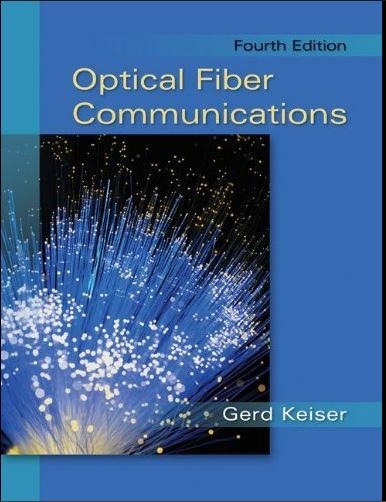
Optical Fiber Communications 4th Edition by Gerd Keiser
Edition 4ISBN: 978-0073380711
Optical Fiber Communications 4th Edition by Gerd Keiser
Edition 4ISBN: 978-0073380711 Exercise 9
A detailed expression for the FWM efficiency is given by 4 
where the factor is the difference of the propagation constants of the various waves due to dispersion, and is given by
Here the value of the dispersion D ( v 0 ) and its slope dD/d , are taken at the optical frequency v 0. Using these expressions in Eq. (12.13), plot the ratio of the generated power P 112 to the transmitted channel power P1as a function of the channel spacing for two +7-dBm channels. Find this ratio for the following dispersion and wavelength values:
( a ) D = 0 ps/(nm ·km) and = 1556.6 nm.
( b ) D = 0.13 ps/(nm ·km) and = 1556.1 nm.
( c ) D = 1.64 ps/(nm ·km) and = 1537.2 nm. Let the frequency spacing of the two channels range from 0 to 250 GHz. In each case, take dD/d = 0.08 ps/(nm 2 · km), = 0.0461 km -1 , L = 11 km, and A eff = 55 m 2. For 1111 and use the values given in Example 12.3.
use the values given in Example 12.3.

where the factor is the difference of the propagation constants of the various waves due to dispersion, and is given by

Here the value of the dispersion D ( v 0 ) and its slope dD/d , are taken at the optical frequency v 0. Using these expressions in Eq. (12.13), plot the ratio of the generated power P 112 to the transmitted channel power P1as a function of the channel spacing for two +7-dBm channels. Find this ratio for the following dispersion and wavelength values:
( a ) D = 0 ps/(nm ·km) and = 1556.6 nm.
( b ) D = 0.13 ps/(nm ·km) and = 1556.1 nm.
( c ) D = 1.64 ps/(nm ·km) and = 1537.2 nm. Let the frequency spacing of the two channels range from 0 to 250 GHz. In each case, take dD/d = 0.08 ps/(nm 2 · km), = 0.0461 km -1 , L = 11 km, and A eff = 55 m 2. For 1111 and
 use the values given in Example 12.3.
use the values given in Example 12.3.Explanation
Plot: from Figure 2 of Y. Jaouën, J-M. P...
Optical Fiber Communications 4th Edition by Gerd Keiser
Why don’t you like this exercise?
Other Minimum 8 character and maximum 255 character
Character 255


